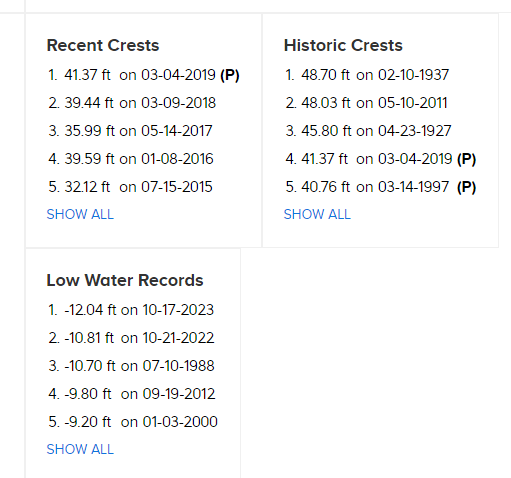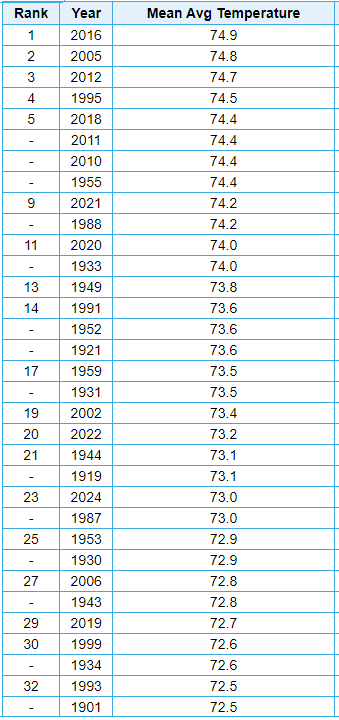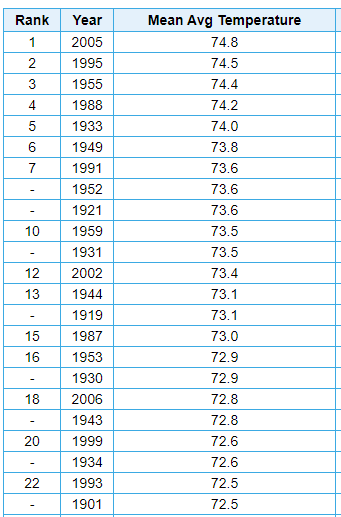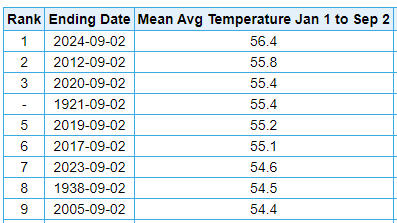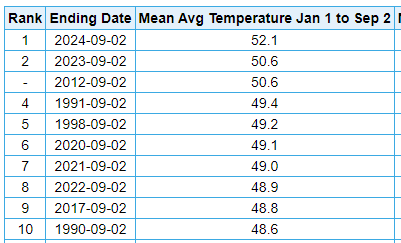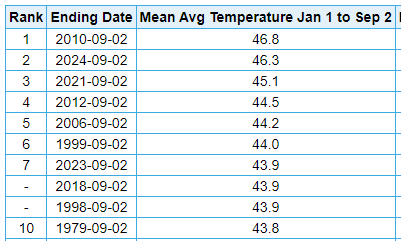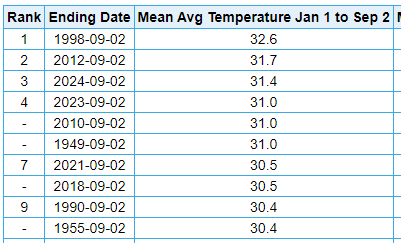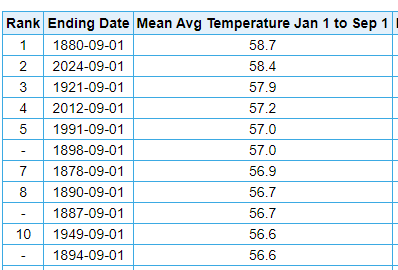
TheClimateChanger
Members-
Posts
4,028 -
Joined
-
Last visited
Content Type
Profiles
Blogs
Forums
American Weather
Media Demo
Store
Gallery
Everything posted by TheClimateChanger
-
Occasional Thoughts on Climate Change
TheClimateChanger replied to donsutherland1's topic in Climate Change
I don't even believe Martz's graphic is accurate. There's no way even the raw data would show 2019 as one of the coldest years. A so-called meteorology student really wants to claim 2019 was colder than the late 70s or some of the other historically cold years in the 19th century and early 20th century. Where was the feet of snow, days and days of below zero weather, etc.? What a joke! I don't even need a thermometer to tell me that's a load of bullcrap. 2019 wasn't even close to the coldest of that decade - years like 2014 & 2015 were obviously colder, which is what the actual data shows. Moreover, deniers used to say in the 1990s and early 2000s, that we were in a warm cycle comparable to the 1930s to 1950s, and it would soon start cooling. Obviously, it has instead continued to warm. But what even was the point of that discussion if that era was actually not warm and instead about the same as the so-called "cold cycle" in the late 1950s to 1980 era? It's laughably stupid. I suspect there's something else going on in that chart - not just TOBs. Like not factoring in station changes [location, elevation, makeup] and/or not properly gridding the data, but instead just taking a mean of whatever station data is available. -
Occasional Thoughts on Climate Change
TheClimateChanger replied to donsutherland1's topic in Climate Change
Martz has previously said the observers were "smart off" to reset the high temperature on the following day. But apparently they weren't smart enough to follow instructions and conform to the observational standards that were in place at the time. -
Correct me if I'm wrong, but unless current warming is outside of the range of modeled projections, there's no need to consider any of these other factors and the warming can be fully explained by greenhouse gas emissions [and other factors already considered in the modeling].
-
September 2024 General Discussion
TheClimateChanger replied to Geoboy645's topic in Lakes/Ohio Valley
Probably the only thing stopping a third consecutive year of record low gauge heights on the lower Mississippi. Currently forecast to approach -9 feet at Memphis (which is where the data below is from). -
Central Pa. Summer 2024
TheClimateChanger replied to mahantango#1's topic in Upstate New York/Pennsylvania
Using 0C/32F, the only areas from 1991-2020 that would qualify as subtropical would be the Philadelphia metro area. Minimum monthly average is 34.0F at PHL and 33.4F at PNE. Also, some areas right along the Mason-Dixon line would qualify marginally. At HGR [Hagerstown, Md.], minimum average monthly temperature is 32.0F and at MGW [Morgantown, W. Va.] 32.1F. Using data from the past 15 years, however, additional areas would qualify, including parts of the Harrisburg area. Average monthly minimum (2010-2024) is 31.5F at MDT, but 32.3F at CXY. So right on the border of continental and subtropical climates, as defined by Koppen, in parts of the Susquehanna Valley over the past 15 years.- 6,666 replies
-
Central Pa. Summer 2024
TheClimateChanger replied to mahantango#1's topic in Upstate New York/Pennsylvania
Only if you use the traditional -3C isotherm for the coldest month as the boundary between subtropical & continental. Typically, 0C is used, especially in North America.- 6,666 replies
-
September 2024 General Discussion
TheClimateChanger replied to Geoboy645's topic in Lakes/Ohio Valley
Latest drought monitor from this morning shows continued expansion of drought conditions across the Ohio Valley. Zanesville has had just 0.88" since July 17, with 0.58" of that falling on July 29. Really only one legitimate chance for rain over the next 10 days there. -
September 2024 General Discussion
TheClimateChanger replied to Geoboy645's topic in Lakes/Ohio Valley
Looks like the cold front moving across the region today and tomorrow should push all of the smoke away for awhile. Perhaps a short window behind the cold front where some smoke can mix down to the surface even across Iowa and Illinois, although concentrations look to stay fairly low so the impact to air quality should be fairly small. -
If you look carefully at the above graphic, you will notice more warming has occurred from the 1990s to today than had occurred from the 1860s to 2000 [or at least a similar degree of warming].
-
For the youngsters today, don't let Dr. Spencer gaslight you into believing the 1990s were unusually cold. The 1990s were the hottest decade of all time at that point in history. Even Dr. Spencer used to argue it was part of some cylical warming trend. He is the most wrong "scientist" of all time. This is how the 1990s used to be displayed when I was growing up: Source: The 1990s was the warmest decade ever recorded instrumentally. The last... | Download Scientific Diagram (researchgate.net)
-
So surreal to see the "warmest decade of all time" [the 1990s - which many of y'all on Wright Weather and later on EasternUsWx.com incorrectly suggested was a "warm cycle" but which I, as a young child, I might add, correctly indicated would be the coldest decade of the rest of your lives] - now appear as frigid cold. I mean it looks colder than the 1800s looked back in the 1990s. Unreal.
-
Pittsburgh, PA Fall 2024 Thread
TheClimateChanger replied to TheClimateChanger's topic in Upstate New York/Pennsylvania
After reviewing the first several posts of the Fall 2023 thread, I can say we are off to a much more fall-like start to September than last year. -
Figured I'd get a fall thread going, now that it's September.
-
Pittsburgh, Pa Summer 2024 Thread.
TheClimateChanger replied to meatwad's topic in Upstate New York/Pennsylvania
Maybe someone needs to get an autumn/fall thread going, now that we are into the month of September? -
Pittsburgh, Pa Summer 2024 Thread.
TheClimateChanger replied to meatwad's topic in Upstate New York/Pennsylvania
-
Pittsburgh, Pa Summer 2024 Thread.
TheClimateChanger replied to meatwad's topic in Upstate New York/Pennsylvania
Some high-altitude wildfire smoke pinwheeling through today. -
One other thing that often gets missed in these discussions is how our very perception of reality is being distorted by the changing norms. One poster described summer as "mostly pleasant" in Detroit - which is obviously a subjective assessment, and I don't mean to impugn that assessment. But if true, pretty much every summer in Detroit is pleasant. If we look at the top 33 hottest summer mean temperatures, we get this: I use 33 years as this is pretty much a "who's who" if you will of hot summers in the Great Lakes region. 2024 ranks as 23rd hottest summer [out of 151 years]. This means historically about 6 out of every 7 summers would be expected to be cooler than 2024 in Detroit. What's very interesting is 8 of the 22 warmer years occurred in the 14 years between 2010 and 2023, inclusive. If we key in on the time frame from 1874 to 2009, we get a markedly different distribution. The same set of years has shrunk from 33 to 23 - the 8 years noted above, plus 2024 & 2019, are out. In this distribution, we find only 14 years [out of 136 total years] were warmer than 2024. In other words, prior to 2009, only about 1 in 10 years were warmer than 2024 [with only 6 of those years warmer by more than 0.6F]. So, 2024 was somewhat cooler than the typical post 2010 summer in Detroit, but very warm historically. There may be some claims that this is the result of some urban heat island expansion, but I would be very, very interested in what changes happened specifically between 2009 and 2010 in the vicinity of Detroit Metropolitan Wayne Airport to explain this phenomenon.
- 231 replies
-
- 1
-

-
- absolute trainwreck?
- abandon all hope?
-
(and 1 more)
Tagged with:
-
September 2024 General Discussion
TheClimateChanger replied to Geoboy645's topic in Lakes/Ohio Valley
Interesting. Most of it appears to be aloft today, but the HRRR suggests a more significant concentration of near surface smoke moving through northern and western Minnesota by Thursday morning. May see some air quality advisories later in the work week if this holds together. -
Yes, but relative to the rest of the country, this was the coldest area. On a national scale, I suspect it will come in a bit below the record value from 2021 and 1936.
- 231 replies
-
- absolute trainwreck?
- abandon all hope?
-
(and 1 more)
Tagged with:
-
Central Pa. Summer 2024
TheClimateChanger replied to mahantango#1's topic in Upstate New York/Pennsylvania
By contrast, there have been an incredible 22 days in which the recorded high temperature was among the 3 warmest daily readings since May 18, 2023, and 27 days in which the recorded minimum temperature was among the 3 warmest of record in that stretch.- 6,666 replies
-
Central Pa. Summer 2024
TheClimateChanger replied to mahantango#1's topic in Upstate New York/Pennsylvania
At Harrisburg, this is the first daily low temperature reading among the top three coldest of any day since May 18, 2023, when the low of 40F was third lowest for that date. Source: Threaded Extremes (rcc-acis.org)- 6,666 replies
-
Central Pa. Summer 2024
TheClimateChanger replied to mahantango#1's topic in Upstate New York/Pennsylvania
Very impressive cold snap this morning in central Pennsylvania. Been awhile since we've seen something like this - maybe May 2020? The low of 36F at Bradford matches the second lowest on record for this date. The low of 44F at DuBois is the 4th lowest reading on record for this date. At Altoona, the low of 43F matches the record low for this date set in 1958 & 1967. And at some longer POR sites... The low of 47F at Williamsport ties 1949, 1960, 1976, 1989 & 2001 for ninth coldest. At Harrisburg, the low of 50F ties 1892, 1893, and 1916 for 3rd coldest on record for this date:- 6,666 replies
-
Occasional Thoughts on Climate Change
TheClimateChanger replied to donsutherland1's topic in Climate Change
Not quite a record for Caribou, Maine or Mount Washington, New Hampshire, but pretty close. Caribou Mount Washington, NH -
Occasional Thoughts on Climate Change
TheClimateChanger replied to donsutherland1's topic in Climate Change
Not so sure about that. 2024 has been the hottest year to date at many locations in the eastern U.S. Including very low population density sites, such as Elkins, West Virginia: And Bradford, Pennsylvania: -
Pittsburgh, Pa Summer 2024 Thread.
TheClimateChanger replied to meatwad's topic in Upstate New York/Pennsylvania
Nevermind. I guess it got so cold in 1880 that it fell way behind. 1921 is the year to beat at 55.4F. We currently have +0.5F on it. The rest of the year in 1921 was +5.9F, +0.7F, +2.1F, +0.3F, relative to 1991-2020 normals. Or about 2.2/2.3F above normal. Since the year is 2/3rd of the way through, 2024 could finish about 0.75F +/- cooler the rest of the way and still tie for the record. So we'd need to run roughly +1.5F, more or less, above the normal for the last 4 months, which is not too much to ask.

